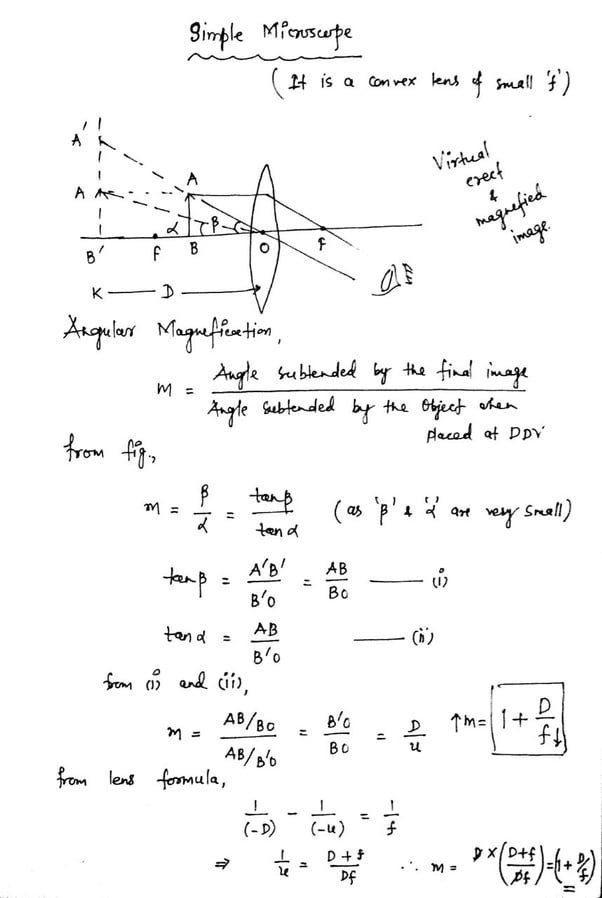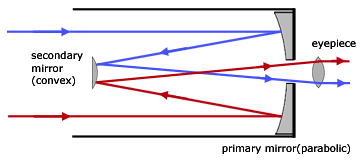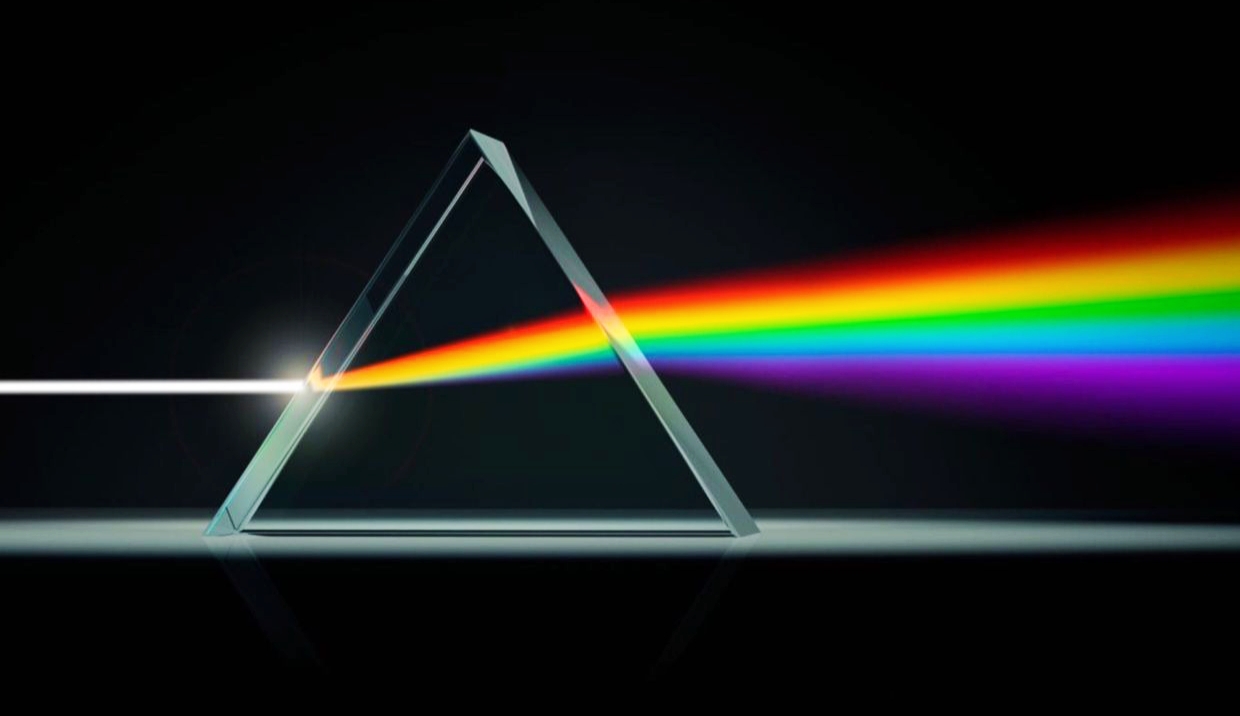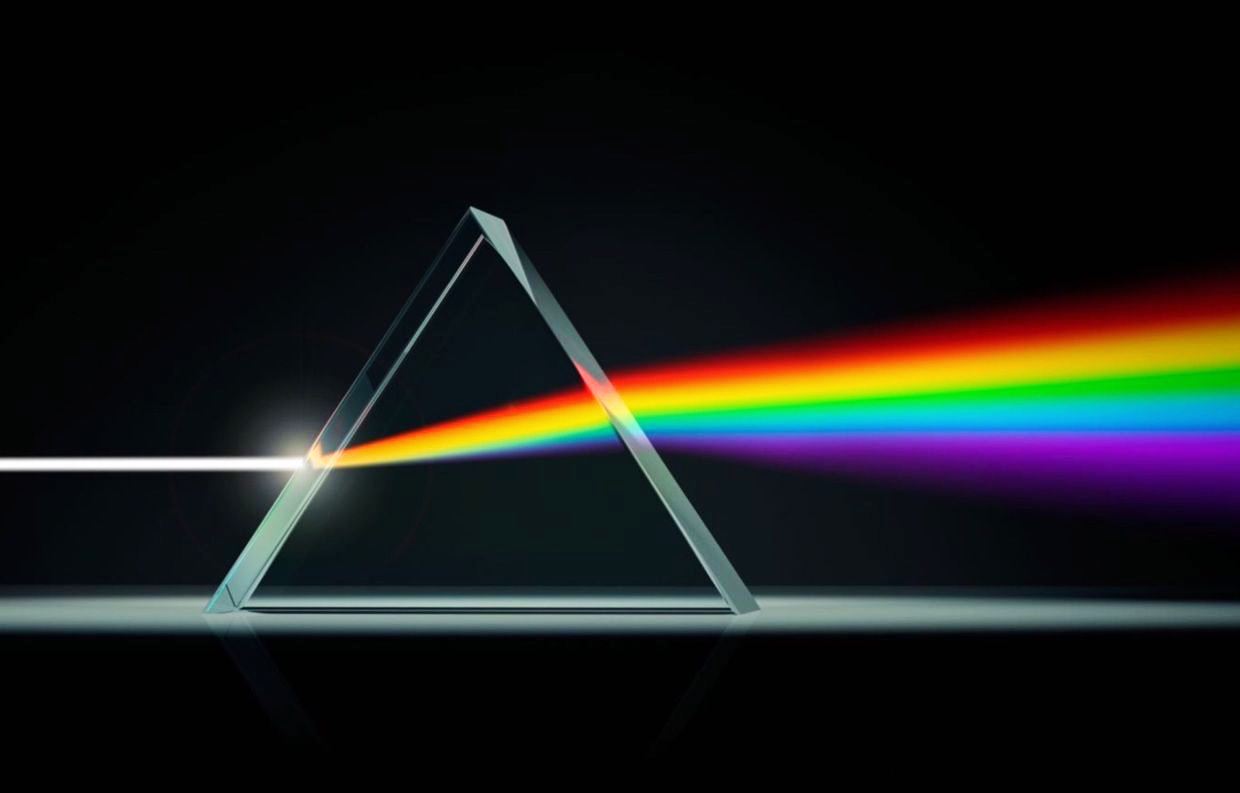Optical microscope:-
The optical microscope, often referred as the light microscope. It is a type of microscope that uses visible light and a system of lenses to magnify images of small objects.
There are two basic types of optical microscope.
1. Simple microscope.
2. Compound microscope.
Simple microscope:-
A simple microscope is actually a Convex lens of small focal length, which is used for seeing the magnified images of small objects.
Principle of simple microscope :-
A simple microscope works on the principle that when object is placed within its focus, a virtual erect and magnified image of the object is formed at the least distance of distinct vision from the eye held close to the lens.
Magnification of Simple microscope :-

The linear magnification m, for the image formed at the near Point D, by a simple microscope can be obtained by using the relation –
m = v/u = v ( 1/v – 1/f )
m = v/v – v/f = 1 – v/f
Now according to sign convention v is negative and equal to D
Thus the magnification
m = 1 + B’C/F’C
m = 1 + D/f
if AB = h is the size of object and A’B’ = h’ is the is the size of image then a missed call to
m = h’/h
Angular magnification of Simple microscope :-

Compound microscope:-
The compound microscope consists of two convex lens. The lens nearest the object called the objective forms real, inverted , magnified image of the object. This serves as the object for the second lens, the eyepiece.
The eyepiece produces the final image , which is enlarged and virtual.
The first inverted image is thus near the focal plane of the eyepiece, at a distance appropriate for final image formation at Infinity or a little closer for image formation at the near point.
Clearly, the final image is inverted with respect to the original object.
The objective lens has a very short focal length

Magnification of Compound microscope :-
The ratio of the angle subtended by the eye by the final virtual image, to the angle subtended at the eye by the object.
Magnifying power
m = β/α = tanβ/tanα = h’/uₑ / h/D = h’/h · D/uₑ = mₒ mₑ
Where β = angle subtended by the eye by the final image, α = angle subtended by the eye by object, h’ = height of image and h = height of object then –
m = h’/h = vₒ/uₒ
The eye piece acts as as a simple microscope
m = vₒ/uₒ ( 1 + D/fₑ )
Where D = distance between eye piece to final image, fₑ = focal length of eyepiece, uₒ= – fₑ , vₒ = L = length of microscope tube then
m = – L/fₒ ( 1 + D/fₑ )
Where fₒ = focal length of the objective.
When image is formed at infinity then
m = mₒ mₑ = ( L/fₒ ) ( D/fₑ )
Telescope:-
The telescope is used to provide angular magnification of distance objects. It also has an objective and an eyepiece, but here the objective has a large focal length and a much larger aperture than the eyepiece.
Light from a distant object enters the objective and a real image is formed in the tube at his second focal Point. The eyepiece magnifies this image producing a final inverted image.
Refracting telescopes can be used both for Terrestrial and Astronomical observations.

Magnifying power of telescope :-
The magnifying power m is the ratio of angle β subtended at the eye by the final image to the angle α which the object subtends at the lens or the eye.
Hence
m = β/α = h/fₑ · fₒ/h = fₒ/fₑ
i. e. m = fₒ/fₑ
In this case the length of telescope tube
L = fₒ + fₑ
If the final image formed at the distance of distinct vision D then magnifying power
m = fₒ/fₑ ( 1 + fₑ/D )
Cassegrain’s Reflecting telescope :-

A Cassegrain’s telescope is a type of reflecting telescope with a folded optical path achieved by two mirrors – a large concave paraboloidal primary with a Central hole and a small hyperboloidal convex mirror mounted on the large front corrector plate.
Light strikes the primary mirror, which reflects the image back to the smaller convex secondary mirror, which in turn reflects the magnified image through the centre hole and on the eyepiece.
The design was conceived in about 1672 by the F. G. Cassegrain.
Question :- A small telescope has an objective lens of focal length 144 cm and an eyepiece of focal length 6·0 cm. What is the magnifying power of the telescope ?What is the separation between the objective and the eyepiece?
Solution –
f₀ = 144 cm
fₑ = 6·0 cm
m = ?
m = fₒ/fₑ = 144 cm/6·0 cm = 24
L = ?
L = fₒ + fₑ = 144 cm + 6·0 cm = 150 cm
Question :- A gaint refracting telescope at an an observatory has an objective lens of focal length 15 cm. If an eyepiece of focal length 1·0 cm is used. What is the angular magnification of the telescope?
Solution –
fₒ = 15 m = 1500 cm
fₑ = 1·0 cm
m = ?
m = fₒ/fₑ = 1500 cm/1·0 cm = 1500
Question:- A small telescope has an objective lens of focal length 140 cm and an eyepiece of focal length 5·0 cm. What is the magnifying power of the telescope for viewing distants object when the final image formed at the least distance of distinct vision ( 25 cm )?
Solution –
fₒ = 140 cm
fₑ = 5·0 cm
D = 25 cm
m = ?
m = fₒ/fₑ ( 1 + fₑ/D )
= 140/5 ( 1 +5/25 )
= 28 x 30/25
Or m = 36·6
Question :- An astronomical telescope ten-fold angular magnification has a length of 44 cm. The focal length of the objective is –
m = 10
fₑ + fₒ = 44 cm
f = ?
m = fₒ/fₑ = 10
fₑ = fₒ/10
Now fₑ + fₒ = 44 cm
Or fₒ + fₒ/fₑ = 44 cm
Or 11 fₒ/10 =44 cm
fₒ = 40 cm











